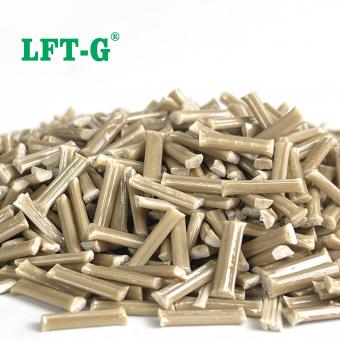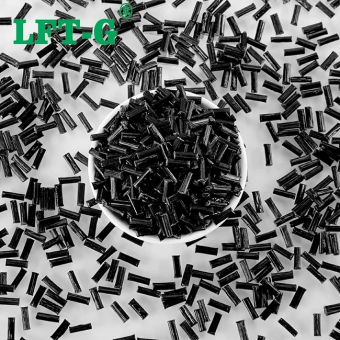Long carbon fiber is a new material with high strength and high modulus and excellent mechanical properties. It is a microcrystalline graphite material obtained by carbonization and graphitization of organic fibers. Its specific gravity is less than 1/4 of steel, and its strength is higher than that of steel. Corrosion resistant, high modulus, no melting. And a variety of resin substrates after impregnation extrusion molding into pellets, long carbon fiber polymer. Can be used for direct molding products. In recent years, it has been widely used in aerospace, mechanical and electronic chemicals.
-
LFT Industrial Virgin Grade Polypropylene Long Carbon Fiber Reinforced Advanced PlasticLFT Plastics are frequently used to replace metal for applications in which light weighting, improved impact strength, elastic modulus, and material strength are required.
- PP LCF CF compounds pellets granules
- Modified thermoplastic resin polymers
- easy to produce for car parts home appliance
- whole sell factory price 25kg/bag
- Low density and weight instead metal and steel
- can be customized plastic 10-12 mm length
Tags :
-
LFT Polyamide 66 high performance long carbon fiber reinforcementPolyamide 66 roving carbon fiber Nylon black color with heat resistance
- Long carbon fiber enhance pellets
- Roving carbon fiber PA66 instead metal and steel
- Nylon66 composite granules for injection
- High quality PA66 long fiber composite、
- Polyamide long fiber composite
- Virgin plastic PA6 LCF40 for car parts
Tags :
-
LFT Polyphenyl Sulfide PPS Long Carbon Fiber Reinforced flame retardantPolyphenylene sulfide is a new functional engineering plastic.
- Polyphenyl sulfide long carbon fibre
- PPS plastic rein forced compounds
- Composite material pps industrial use
- Filling lcf 30 pps composite plastic new materials
- High flame retardant car parts
- Factory use raw material modified plastic high performance
Tags :
-
Xiamen LFT-G PLA Polylactic acid composite long carbon fiber thermoplastic resinWhat is long carbon fiber PLA? While biobased polylactic acid (PLA) thermoplastics are relatively eco-friendly and easy to recycle, composites such as carbon fibre are much stronger. Long carbon fiber reinforced PLA is an outstanding material that is strong, lightweight, has excellent layer bonding and low warpage. It has excellent layer adhesion and low warpage. Long carbon fiber PLA is stronger than other 3D-printed materials. Long carbon fiber filaments are not as strong as other 3D materials, but tougher. The increased rigidity of carbon fiber means increased structural support but reduced overall flexibility. It is slightly more brittle than regular PLA. When printed, the material is a dark glossy color that shimmers slightly under direct light. What is long carbon fiber? Long carbon fiber reinforced composites offer siginificant weight savings and provide optimum strength and stiffness properties in reinforced thermoplastics. The excellent mechanical properties of long carbon fiber reinforced composites make it an ideal replacement for metals. characteristic The fracture strain is moderate (8-10%), so the silk is not brittle, but strong toughness Very high melt strength and viscosity Good dimensional accuracy and stability Easy to handle on many platforms High attractive matte black surface Excellent impact resistance and lightness Application of long carbon fiber PLA materials Long carbon fiber PLA is an ideal material for frame, support, shell, propeller, chemical instrument and so on. Drone makers and RC enthusiasts especially like it, too. Ideal for applications requiring maximum stiffness and strength. Details Number PLA-NA-LCF30 Color Original black (can be customized) Length 12mm (can be customized) MOQ 20kg Package 20kg/bag Sample Available Delivery time 7-15 days after shipment Port of Loading Xiamen Port Exihibition We will offer you: 1. LFT & LFRT material technical parameters and leading edge design 2. Mold front design and recommendations 3. Provide technical support such as injection molding and extrusion molding
- PLA LCF original color resin made in China
- Polylactic acid filling long carbon fiber
- PLA resin lcf reinforced plastic pellets
- LFT cpmpounds pla manufacturer direct sell
- lcf reinforced material pla good price
- Thermoplastic pla lcf instead metal CF
Tags :
-
LFT High Properties Polyetheretherketone Long Carbon Fiber Reinforced Thermoplastic CompoundsThe mechanical properties of PEEK allow it to be used as reinforcement material in various scenarios.
- carbon fiber reinforced peek mechanical properties
- peek 30 carbon fiber-reinforced
- peek carbon fiber composite
- peek material advantages and disadvantages
- peek material aerospace
- polyetheretherketone (peek) for medical applications
Tags :
-
LFT Polyphenylene Sulfide engineering plastic with long glass fiber reinforcementPure PPS is rarely used alone due to its brittle performance. Most of the PPS used is its modified variety. Glass fiber reinforced PPS is one of them.
- Long fiber PPS applications
- PPS mechanical properties
- PPS electrical insulation
- Glass fiber PPS
- Long Fiber Reinforced PPS
- PPS thermal resistance Chemical resistant
Tags :
-
LFT Polyphenylene sulfide PPS Long Carbon fiber Reinforced PPS PelletsMost of the PPS used is its modified variety. Glass fiber reinforced PPS is one of them.
- Long Fiber Thermoplastics (LFT) Market Growth
- Polyphenylene Sulfide (PPS) Composites
- Carbon Fiber Reinforced Polymers (CFRP) Innovations
- Lightweighting in Automotive Design
- Thermoplastic Composite Recycling
- Sustainability in Composite Materials
Tags :
-
LFT Polyphenylene Sulfide engineering plastic with long glass fiber reinforcementPure PPS is rarely used alone due to its brittle performance. Most of the PPS used is its modified variety. Glass fiber reinforced PPS is one of them.view more
-
LFT Polyamide 66 high performance long carbon fiber reinforcementPolyamide 66 roving carbon fiber Nylon black color with heat resistanceview more
-
LFT-G Polyamide 12 long carbon fiber reinforced compounds nylon for car partsLong carbon fiber Carbon fiber has many excellent properties, high axial strength and modulus, low density, high specific performance, no creep, super high temperature resistance in non-oxidizing environment, good fatigue resistance, specific heat and electrical conductivity between non-metal and metal, small coefficient of thermal expansion and anisotropy, good corrosion resistance, good X-ray transmission. Good electrical and thermal conductivity, good electromagnetic shielding, etc. Compared with traditional glass fiber, carbon fiber has more than 3 times of Young's modulus; it is about 2 times of Young's modulus compared with Kevlar fiber, which is insoluble and swollen in organic solvents, acids and alkalis, and has outstanding corrosion resistance. But is there a way to reduce the price of carbon fiber? That is to mix it with relatively cheap nylon material to form a composite material with good performance and meet the requirements. In that case, there is no doubt that carbon fiber nylon will definitely have a place in the composite material. Nylon itself is an engineering plastic with excellent performance, but moisture absorption, poor dimensional stability of products. Strength and hardness are also far from metal. In order to overcome these shortcomings, as early as before the 70s. People have used carbon fiber or other varieties of fibers for reinforcement to improve its performance. Carbon fiber reinforced nylon materials have developed rapidly in recent years, because nylon and carbon fiber are excellent performance in the field of engineering plastics materials, its compound material synthesis reflects the superiority of the two, such as strength and rigidity than unreinforced nylon is much higher, high temperature creep is small, thermal stability has improved significantly, good dimensional accuracy, wear resistance. Excellent damping, compared with glass fiber reinforced has better performance. Therefore, carbon fiber reinforced nylon (CF / PA) composites have developed rapidly in recent years. And for 3D printing using SLS technology is the most suitable technical means to achieve carbon fiber reinforced nylon. TDS for reference Application Our company Xiamen LFT composite plastic Co., Ltd is a brand-name company that focuses on LFT&LFRT. Long Glass Fiber Series (LGF) & Long Carbon Fiber Series (LCF). The company's thermoplastic LFT can be used for LFT-G injection molding and extrusion, and can also be used for LFT-D molding. It can be produced according to customer requirements: 5~25mm in length. The company's continuous infiltration reinforced thermoplastics have passed ISO9001&16949 system certification, and the products have obtained lots of national trademarks and patents.
- long fibre reinforced thermoplastics
- carbon fiber reinforced plastics granules
- long carbon fiber reinforced pa12
- long fiber composite pa6 granules
- pa6 lcf polymers carbon fiber CFRP good price polymer
Tags :
-
LFT-G Nylon 6,6 Thermoplastic Resin filled Long Carbon Fiber CompoundsNylon 66 material for machining has improved temperature resistance and lower rates of water absorption when compared to standard nylon 6.
- Carbon fiber PA66 composites
- Lightweight structural materials
- High-strength polyamide 66
- Automotive carbon fiber composites
- Carbon fiber reinforced nylon durability
- Advanced thermoplastic composites
Tags :
-
LFT Polyamide 6 High Strength Long Carbon Fiber Reinforcement CompoundsPolyamide 6 is a common engineering plastic with excellent mechanical properties, chemical resistance and wear resistance.
- excellent heat resistant properties
- LCF CFRP Advanced composites
- 3D printing with reinforced polyamides
- Supply chain of carbon fiber reinforced polyamide
- Cost-effectiveness of long fiber composites
- Industrial machinery parts
Tags :

 e-mail
e-mail English
English français
français Deutsch
Deutsch русский
русский italiano
italiano español
español português
português العربية
العربية 日本語
日本語 한국의
한국의 中文
中文





















